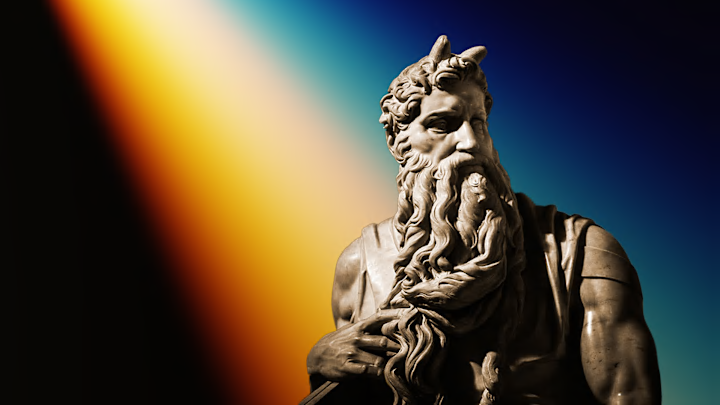Michelangelo’s Moses has more in common with C.S. Lewis’s Mr. Tumnus than the casual viewer might expect—namely, a couple of stubby horns. Michelangelo wasn’t the first artist to depict the Hebrew leader with cranial appendages; he was upholding a centuries-old custom based on a biblical description.
But there’s an ongoing dispute about what the description actually means.
A Metaphor for Moses’s Metamorphosis
In Chapter 34 of the Old Testament’s Book of Exodus, Moses communes with God on Mount Sinai to renew a broken covenant between God and the Israelites. Unbeknownst to Moses, the interaction has changed his appearance—which frightens the Israelites into keeping their distance when they see Moses descending the mountain with the terms of said covenant (the Ten Commandments) in hand.
It’s generally agreed that something happened to Moses’s face (or, more specifically, the skin of his face). But the details are up for debate thanks to qāran, an obscure verb form of the Hebrew noun qeren, meaning “horns.” While the literal read suggests that Moses’s face “was horned,” some translations interpret qāran figuratively as “shone” or something to that effect.

The Septuagint—which, at roughly 2200 years old or more, is the earliest existing Greek translation of the Hebrew Old Testament—took the latter tack, calling the skin of his face “charged with glory” or “glorified” (depending on the English translation). But when the Roman Catholic priest (and later saint) Jerome translated the Bible into Latin circa the late 4th and early 5th centuries CE, he wrote that “cornuta esset facies sua,” or “his face was horned.”
Some people have assumed that Jerome didn’t realize qāran had another (arguably more suitable) definition and that horned was essentially a mistranslation. But there’s evidence to the contrary: In his commentaries on prophets, Jerome uses both glorified and horned in reference to Moses’s transformation. He also mentions that Aquila of Sinope opted for horned in his influential Greek translation of the Hebrew Bible circa the 2nd century BCE. Only fragments of Aquila’s original translation have survived, and scholars typically cite Jerome himself as the source of the claim that Aquila interpreted qāran to mean “horned.” In other words, it’s tough to verify. But the claim alone pretty much proves that Jerome’s own use of the term horned wasn’t an ill-informed mistake—and he evidently knew that glorified was on the table, too.

Whether Jerome meant horned in the literal sense is yet another debate. He could have: As Ruth Mellinkoff wrote in 1970’s The Horned Moses in Medieval Art and Thought, “From ancient civilizations into modern times, the horned head or headdress symbolized divinity, honor, power.” Not only were deities often horned themselves—with examples in virtually every ancient religion from Mesopotamia to Scandinavia—but horns could also “transfer divinity and power to those things on which they were placed,” Mellinkoff explained. That said, Mellinkoff found it more likely that Jerome just intended the horns as a metaphor for Moses’s now very apparent power. Horns do crop up throughout the Bible as a figurative reference to honor, might, salvation, and all manner of other abstractions.
Why Not Both?

Whatever the case, Jerome’s translation (a.k.a. the Vulgate) became hugely popular, and other translators followed suit in making Moses horned. Key among them was Aelfric, whose 11th-century translation of the Bible into Old English featured illustrations of Moses with actual horns. As the Middle Ages progressed and eventually gave way to the Renaissance, various artists portrayed the prophet with a pair of prongs.
But plenty of biblical scholars still favored a more figurative route. Some, including 11th-century French rabbi Rashi, bridged the gap between the two interpretations by positing that horn-shaped rays of light shone from Moses’s face or head—an image also very common in art over the ages.

Pick up a copy of the Bible these days, and you’re most likely to read that the “skin of {Moses’s} face shone.” That’s what the King James Version, the New American Standard Bible, and the English Standard Version all say, while the New International Version and the New Living Translation simply describe Moses’s face as “radiant.” It does seem like a more intuitive take, especially given the original Hebrew passage’s focus on the skin of Mose’s face (it’s weird to describe someone’s face skin as “horned”).
Not to mention that horns are now more closely associated with devils than deities—meaning people could easily misinterpret Moses’s horns as a sign of evil. In fact, antisemitic artists have long used horns to dehumanize Jewish people; classicist Stephen Bertman has even argued that was Michelangelo’s intent in sculpting Moses with horns. If it was, Old Testament scholar Brent A. Strawn wrote for TheTorah.com, “I think it likely that the master artist failed miserably. Anyone who has stood before that great work of art is impressed, not horrified, by its rendition of Moses.”
Read More About Religion:
